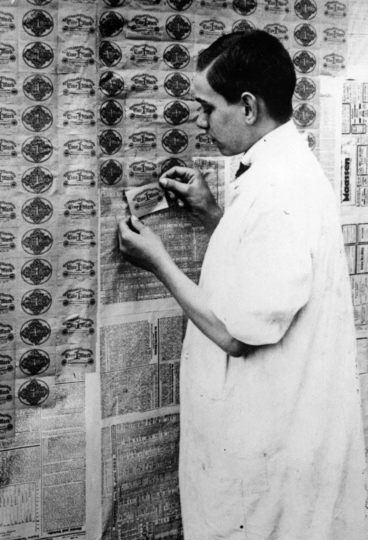Ph.D. candidate and dramaturg Georgia Beckmann reflects on the true history of the Weimar Republic at the center of Cabaret, and the questions the show continues to ask of its audiences.
Part of what makes Cabaret so compelling is that while it is allegorical in nature, this iconic musical is also rooted in real people and real histories. Cabaret is based on a play, which is based on the auto-fictional writings of Christopher Isherwood, a gay English author who lived in Berlin, Germany from 1929 to 1933. From a first-hand yet culturally-removed vantage point, Isherwood witnessed the fall of the Weimar Republic and the rise of the Nazi dictatorship. Though fictionalized, Cabaret is shrouded in truth: its characters are inspired by real people, its plot touches on real events and its structural premise of a cabaret show represents the vibrant queer nightlife of Weimar Berlin.

As the production’s dramaturg, my role has been rooted in various forms of research. Over the summer, I produced an accessible, nineteen-page packet of synthesized research for actors to review. My main goals with this packet were to provide context into the history of Cabaret as a musical, its source material, the history of the Weimar Republic, its contemporary allegories and the Brechtian lens implemented in the show’s structure. At the beginning of the rehearsal process, I gave a presentation to actors and the directing team with greater and more detailed information about the Weimar Republic up until 1930, the year in which the musical takes place. What was it like to live through the Hyperinflation Crisis of 1923? What was it like to frequent the clubs that inspired Isherwood? What was it like to live in a city at the intersection of unprecedented social progressivism and the rising fascist nationalism?
For actors, it was essential to produce research about the Weimar Republic through 1930, as that is the year in which the play’s narrative ends. There was no way for Cabaret’s characters to know for certain how or the extent to which mass violence would be orchestrated by the Nazis after 1930. There was no way for these characters to know that less than twenty-four months after the end of Cabaret, the queer nightlife that had invigorated our characters, would be quashed. There was no way to predict with certainty that over the course of the next fifteen years, the Nazi regime would relocate, imprison and/or kill millions of Jewish, queer, transgender, politically-dissident, and disabled people in addition to others labelled as “degenerate” or “un-German.”


However, from the vantage point of audiences attending our show, there is more expansive historical awareness about the aftermath of the Nazis’ rise to power. To support this understanding of the show’s content and context, I—supported by the dramaturgy, set design and directing teams—designed a lobby display titled “Welcome to Berlin, 1914-1946.” When you come to see Cabaret, I encourage you to check it out before or after the show. Contained in this display is a variety of figures, images, questions and events that were central to our process of imagining what our Cabaret would be. To further historically situate audiences, there is also a timeline that lays out key events leading up to and following when the musical takes place.
As a text, this musical engages its subject matter and setting, the era in which the work was conceived, and every subsequent

context within which it has been presented. Today, Cabaret holds the history of the rise of Nazism at the end of the Weimar Republic alongside an impression of Isherwood’s writings alongside the civil rights, Vietnam War protest, queer rights and second-wave feminist movements of the 1960s in the United States alongside the HIV/AIDS epidemic, neoliberalism and the growing military conflict in Iraq during the late 1990s. As we rehearse and prepare to perform this show, the current moment—the in-process histories developing as you read this blog post—is also being woven into the fabric of Cabaret. This show is an exercise in critical thinking and agency for its artists and audiences.

I will leave you with the questions that have guided my process as the dramaturg of our Cabaret, through engagement with newspaper archives, scholarly texts, popular sources, generative conversations, class visits, program notes, numerous rehearsals and panels. I share them in the hope that they might help to frame your thinking around our collective interpretation of Cabaret. How long will one stay passive for the sake of convenience, safety or power? How easy is it to remain fast asleep as violence is inflicted on those around you? Why and how does fascism overtake a country and a people? Who gets to continue dancing while others suffer the end of the world?
Written by Georgia Beckmann.

